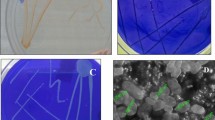Abstract
The role of hydrolytic enzymes (proteases and chitinase) and oxidative stress in the autolysis and morphology of Blakeslea trispora during β-carotene production from a chemically defined medium in shake flask culture was investigated. The process of cellular autolysis was studied by measuring the changes in biomass dry weight, pH, concentration of β-carotene, specific activity of the hydrolytic enzymes and micromorphology of the fungus using a computerized image analysis system. In addition, the phenomenon of autolysis was associated with high concentrations of reactive oxygen species (ROS). The accumulation of ROS produced during fermentation causes oxidative stress in B. trispora. Oxidative stress was examined in terms of the activities of two key defensive enzymes: catalase (CAT) and superoxide dismutase (SOD). The profile of the specific activities of the above enzymes appeared to correlate with the oxidative stress of the fungus. The high activities of CAT and SOD showed that B. trispora is found under oxidative stress during β-carotene production. The culture began to show signs of autolysis nearly in the growth phase and autolysis increased significantly during the production phase. The morphological differentiation of the fungus was a result of the degradation of the cell membrane by hydrolytic enzymes and oxidative stress. Increased β-carotene production is correlated with intense autolysis of clumps, which has as a consequence the increase of the freely dispersed mycelia.






Similar content being viewed by others
References
Beauchamp C, Fridovich I (1971) Superoxide dismutase: improved assays and an assay applicable to acrylamide gels. Anal Biochem 44:276–287
Chandra J, Samali A, Orrenius S (2000) Triggering and modulation of apoptosis by oxidative stress. Free Radic Biol Med 29:323–333
Emri T, Pocsi I, Szentirmai A (1997) Glutathione metabolism and protection against oxidative stress caused by peroxides in Penicillium chrysogenum. Free Radic Biol Med 23:809–814
Gessler N, Sokolov A, Bykhovskii VI, Belozerskaia T (2002) Superoxide dismutase and catalase activities in carotenoid-synthesizing fungi Blakeslea trispora and Neurospora crassa fungi in oxidative stress. Appl Biochem Microbiol 38:237–242
Goksungur Y, Mantzouridou F, Roukas T (2002) Optimization of the production of β-carotene from molasses by Blakeslea trispora: a statistical approach. J Chem Technol Biotechnol 77:933–943
Goksungur Y, Mantzouridou F, Roukas T, Kotzekidou P (2004) Production of β-carotene from beet molasses by Blakeslea trispora in stirred-tank and bubble column reactors. Appl Biochem Biotechnol 112:37–54
Harvey L, McNeil B, Berry D, White S (1998) Autolysis in batch cultures of Penicillium chrysogenum at varying agitation rates. Enzyme Microb Technol 22:446–458
Jüsten P, Paul G, Nienow A, Thomas C (1996) Dependence of mycelial morphology on impeller type and agitation intensity. Biotechnol Bioeng 52:634–648
Kreiner M, McNeil B, Harvey L (2000) “Oxidative stress” response in submerged cultures of a recombinant Aspergillus niger (B1-D). Biotechnol Bioeng 70:662–669
Kreiner M, Harvey L, McNeil B (2003) Morphological and enzymatic responses of a recombinant Aspergillus niger to oxidative stressors in chemostat cultures. J Biotechnol 100:251–260
Larsen M, Kristiansen K, Hansen T (1998) Characterization of the proteolytic activity of starter cultures of Penicillium roqueforti for production of blue veined cheeses. Int J Food Microbiol 43:215–221
Mantzouridou F, Roukas T, Kotzekidou P (2002a) Optimization of β-carotene production from synthetic medium by Blakeslea trispora in a stirred tank reactor and relationship between morphological changes and pigment formation. Food Biotechnol 16:167–187
Mantzouridou F, Roukas T, Kotzekidou P (2002b) Effect of the aeration rate and agitation speed on β-carotene production and morphology of Blakeslea trispora in a stirred tank reactor: mathematical modeling. Biochem Eng J 10:123–135
Mantzouridou F, Roukas T, Kotzekidou P, Liakopoulou M (2002c) Optimization of β-carotene production from synthetic medium by Blakeslea trispora. A mathematical modeling. Appl Biochem Biotechnol 101:153–175
Mantzouridou F, Roukas T, Kotzekidou P (2004) Production of beta-carotene from synthetic medium by Blakeslea trispora in fed-batch culture. Food Biotechnol 18:343–361
McNeil B, Berry D, Harvey L, Grant A, White S (1998) Measurement of autolysis in submerged batch cultures of Penicillium chrysogenum. Biotechnol Bioeng 57:297–305
Medentsev A, Arinbasarova A, Akimenko V (2001) Adaptation of the phytopathogenic fungus Fusarium decemcellulare to oxidative stress. Microbiology 70:26–30
Paul G, Thomas C (1998) Characterization of mycelial morphology using image analysis. Adv Biochem Eng Biotechnol 60:1–59
Pazdzioch-Czochra M, Widenska A (2002) Spectrofluorimetric determination of hydrogen peroxide scavenging activity. Anal Chim Acta 452:177–184
Ramirez M, Avelizapa L, Avelizapa N, Camarillo R (2004) Colloidal chitin stained with remazol brilliant blue R, a useful substrate to select chitinolytic microorganisms and to evaluate chitinases. J Microbiol Methods 56:213–219
Roukas T, Mantzouridou F (2001) An improved method for extraction of β-carotene from Blakeslea trispora. Appl Biochem Biotechnol 90:37–45
Roukas T, Mantzouridou F, Boumpa T, Vafiadou A, Goksungur Y (2003) Production of β-carotene from beet molasses and deproteinized whey by Blakeslea trispora. Food Biotechnol 17:203–215
Schacterle G, Pollack R (1973) A simplified method for the quantitative assay of small amounts of protein in biologic material. Anal Biochem 51:654–655
Tucker K, Kelly T, Delgrazia P, Thomas C (1992) Fully-automatic measurement of mycelial morphology by image analysis. Biotechnol Prog 8:353–359
Wang C (1995) Effect of temperature preconditioning on catalase, peroxidase, and superoxide dismutase in chilled zucchini squash. Postharvest Biol Technol 5:67–76
Author information
Authors and Affiliations
Corresponding author
Rights and permissions
About this article
Cite this article
Nanou, K., Roukas, T. & Kotzekidou, P. Role of hydrolytic enzymes and oxidative stress in autolysis and morphology of Blakeslea trispora during β-carotene production in submerged fermentation. Appl Microbiol Biotechnol 74, 447–453 (2007). https://doi.org/10.1007/s00253-006-0666-1
Received:
Revised:
Accepted:
Published:
Issue Date:
DOI: https://doi.org/10.1007/s00253-006-0666-1




